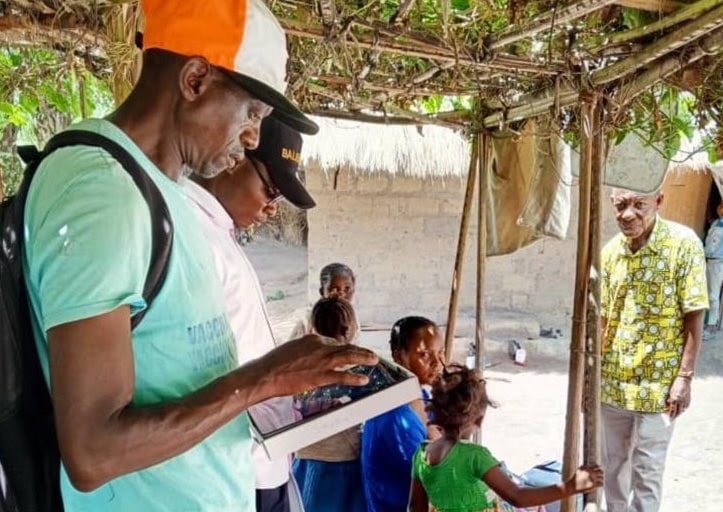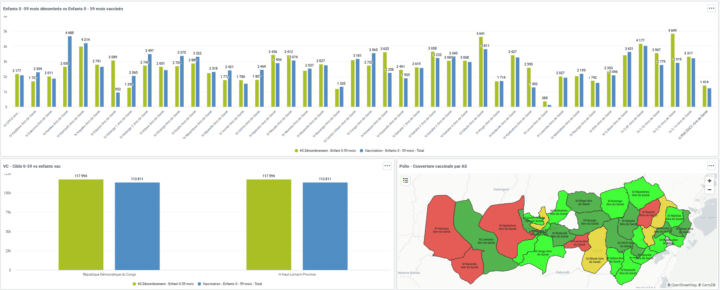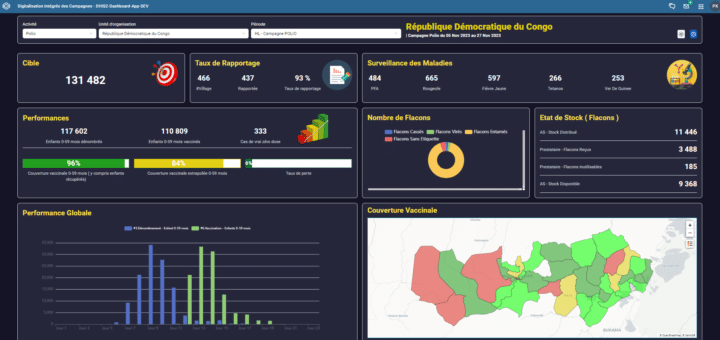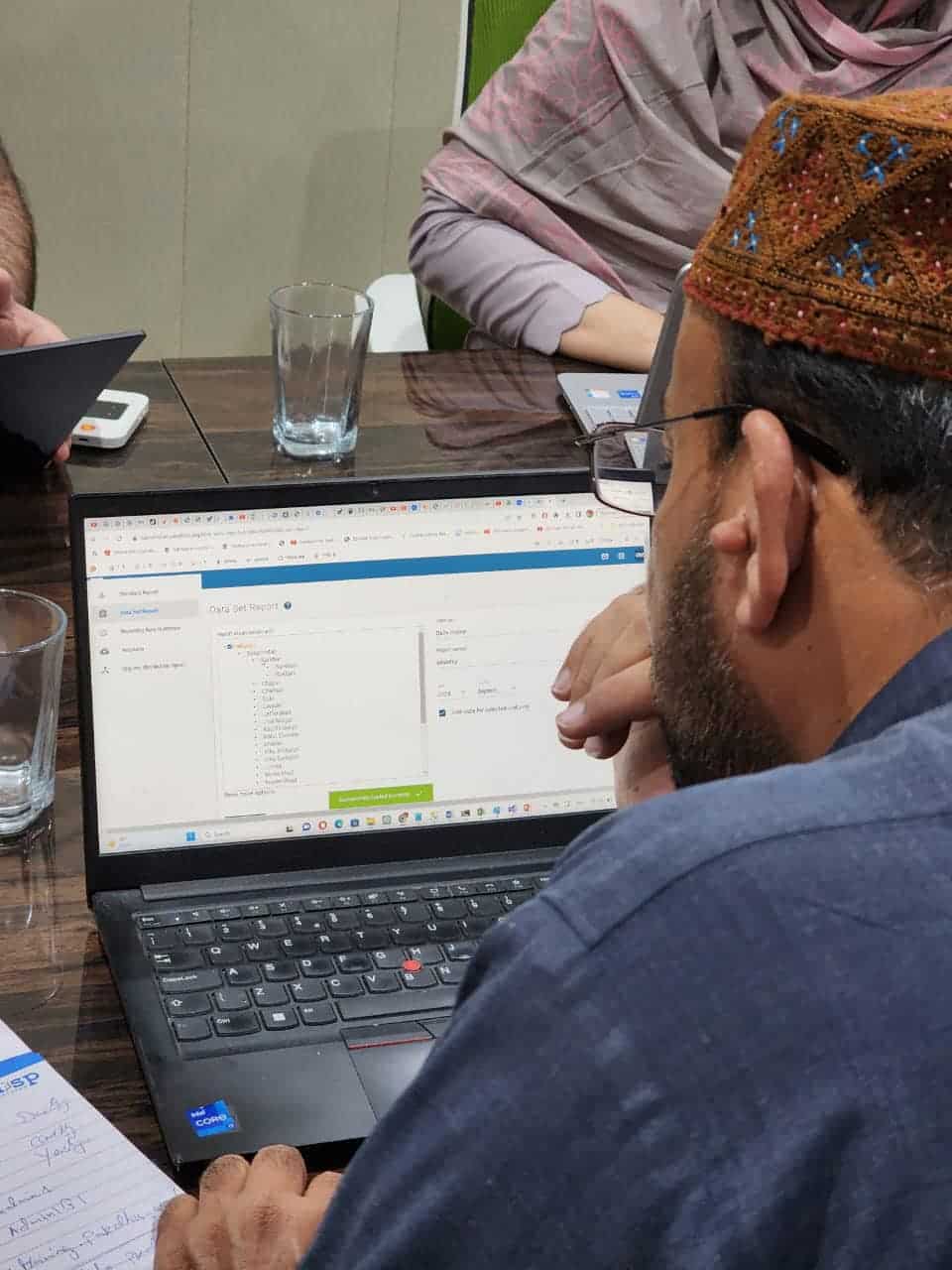
Reaching zero-dose children in Democratic Republic of the Congo with the DHIS2 campaign platform
Using DHIS2 for polio vaccination campaign management, health workers in two districts of the DRC achieved 96% coverage for children under age 5, including hundreds of “zero dose” cases
Though the wild poliovirus was officially eradicated in the Democratic Republic of the Congo (DRC) in 2011 and approximately 80% of children have been vaccinated against the disease, the country has faced recurrent outbreaks of circulating vaccine-derived poliovirus (cVDPV), which most often occurs in areas with low vaccination rates. According to a WHO report from 2023, the DRC represented almost half of the total number of reported cases of cVDPV type 2 in the Africa region, with 407 cases reported between January 2022 and June 2023. The DRC poses particular challenges for vaccination campaigns, because of its large size—roughly the size of western Europe—low population density, rugged terrain, and ongoing armed conflicts, all of which can make it very difficult for health workers to reach many of the nation’s children.
To boost polio immunity and prevent additional future outbreaks, the DRC’s Ministry of Public Health, Hygiene and Prevention launched a polio vaccination campaign in the Haut-Lomami region in November 2023. The campaign used DHIS2 to plan, monitor, and evaluate activities in real time, thanks to the Integrated Digitization of Public Health Campaigns project, an initiative funded by the Bill and Melinda Gates Foundation and the Clinton Foundation, with technical support from the HISP West and Central Africa (WCA) and HISP DRC groups. These efforts complement ongoing immunization system strengthening support from Gavi, the Vaccine Alliance. This was the first time DRC has used DHIS2 for campaign management, and it achieved an overall vaccination rate of 96% for children under the age of five, including more than 300 true “zero dose” patients.
The DHIS2 campaign dashboard was well received by users and was key to the effort’s success.
“Users told us it was a good experience for them to have information in real time, because in the past they had a lot of problems using and analyzing data. In this campaign, they had the information they needed.”
– Souleymane Samaké, HISP WCA
Focusing on data to plan and implement an effective vaccination campaign
The DRC polio vaccination campaign used DHIS2 to monitor enumeration and vaccine distribution for roughly 117,000 children in 426 villages within the Haut-Lomami region. This effort followed a larger national polio vaccination campaign in June 2023, which targeted more than 17 million children under the age of 5, across 20 of the nation’s 26 provinces. The June 2023 campaign was the DRC’s first large-scale polio vaccination effort using the nOPV2 vaccine, of which more than 600 million doses have already been administered in the World Health Organization (WHO) Africa region since 2021. This effort is part of “The Big Catch-Up,” an initiative by WHO, UNICEF, and Gavi, the Vaccine Alliance, with support from the Immunization Agenda 2030 Partnership. It aims to close the immunity gap that resulted from reduced vaccine access during the Covid-19 pandemic.
The vaccination campaign team for the November 2023 effort consisted of 44 immunization technicians, 45 supervisors, and 115 health workers in the field. HISP WCA had created training materials and audio-visual aids to guide these new users through the process and familiarize them with the DHIS2 platform and tools. New trainers were educated on the fundamentals of campaign organization, and they in turn trained the end users in each of the health areas.
After training was complete, community health workers began the enumeration phase by locating and counting children under the age of 5 in each of the 426 villages of Kabondo Dianda and Kamina. Workers used the DHIS2 Android Capture app on tablets to enter the data at the village level, building on existing organization units in the DRC’s country database. Through a Tracker program, team members captured information about each of the 64,711 households, such as a phone number, or the name of the head of household, as well as the number of children under 5 living there. Each household entry was tagged with geocoordinates to facilitate campaign planning and make it easier to locate the children during the vaccination phase.

DHIS2 transforms vaccination campaign
During the first stage of the campaign, workers were able to count 117,594 children under the age of 5 across the region. This was 12% below the initial population estimate of 133,000, allowing the team to adjust their vaccination plans accordingly. In the second stage, just days later, the team distributed the vaccines and community health workers administered doses to 110,809 children, including 333 with no previous history of vaccination. This represents a 96% vaccination rate when compared to the enumerated population. During the vaccination phase, community health workers captured data on both children vaccinated and vaccine logistics, so that stock-outs could be reported immediately. The team has also identified discrepancies with some logistics data being reported at the end-user level, and is working to understand and resolve the issue for future campaigns.
Key stakeholders in the vaccination campaign, including the DRC Ministry of Public Health, the Clinton Health Access Initiative (CHAI), and the WHO country office held daily analysis meetings throughout the vaccination campaign, using DHIS2 immunization dashboards to review the campaign’s status. The goal was to monitor the process from enumeration to vaccine distribution, and take target action to ensure that the campaign reached its goals. By first obtaining a more accurate count of the children in the target age group, workers were able to more precisely distribute the vaccines and prevent waste. By monitoring the data in real time, the campaign team was able to analyze their progress and adjust their plans while the campaign was still underway—something that was impossible in previous campaigns.
“Digitizing the polio campaign has had a transformational impact on a number of levels. Thanks to DHIS2, healthcare professionals were able to collect and analyze evidence-based data in real time, leading to a more targeted and accurate intervention and sparing providers the manual data compilation exercise at the end of the day that was often at the root of certain errors.”
– Patty Keto, HISP DRC group lead
Additionally, DHIS2 dramatically improved campaign reporting—which could often take more than a week in previous campaigns—providing instantaneous reporting in areas with permanent internet connectivity and enabling reporting in less than 24 hours in areas where connectivity is not readily available. The decreased reporting time was key to more informed decision making, according to Dr. Christophe Luhata of the Ministry of Public Health’s Expanded Programme on Immunization. “I appreciated the improvement in the prompt reporting of campaign data, as it allowed for timely decision making,” he said.

Utilizing partnership with HISP WCA to build custom DHIS2 dashboard
In the early stages of this campaign, CHAI provided a mockup for a custom dashboard layout with specific desired features to support the effort, including a national target, reporting rate, disease surveillance, and stock status. HISP WCA then developed the requested dashboard as a custom application in DHIS2, ultimately producing two versions, the second of which includes dark mode, which can extend battery life on mobile devices.
The custom dashboard pulls data from DHIS2 and presents it in custom visualizations that were tailored to CHAI’s requirements. It features a dropdown menu to allow users to switch between several campaigns or diseases, so it is designed to be flexible and reusable, with potential for adaptation to other kinds of campaigns. While this new dashboard was still in development during the polio vaccination campaign, HISP WCA and HISP DRC hope to deploy it for use in future campaigns, such as the follow-up campaign for measles vaccinations that is planned in 2024 in the DRC. HISP WCA also hopes to further expand the custom dashboard app so that it can be used for disease surveillance as well.

This article is based on reports from HISP WCA and HISP DRC, members of the HISP network.


